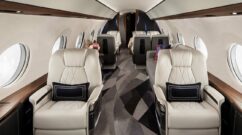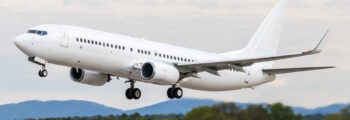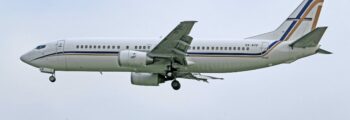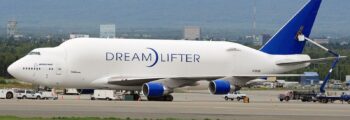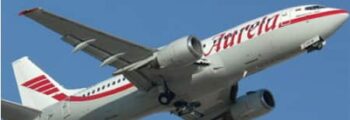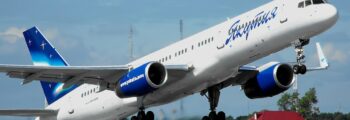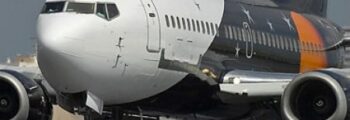Boeing is an American aerospace manufacturer. The aerospace group is among the world’s leading manufacturers alongside Airbus, Dassault, and Bombardier. The aerospace company was founded in Seattle, USA, in 1916 by William Edward Boeing, an aviator and entrepreneur. Boeing carries out various design and manufacturing missions for aircraft, both in defense aviation, military, space, as well as in civil aviation, and for the manufacture of various aerospace equipment. Let’s look back together at the history and actions of this company, a true pioneer in the world of aviation.
Boeing today
Some figures:
The Boeing group operates in more than 150 countries and employs 150,000 people.
The revenue for the aircraft manufacturer Boeing in 2021 is
The group is structured around different activities:
– commercial aviation
– defense
– space and security
– global services
Boeing: a committed company
Boeing is committed! Indeed, the aircraft manufacturer takes its responsibilities and invests in various actions:
– citizen actions: Each country, as part of Boeing Global Engagement, selects a commitment focus for which the company will invest locally, supporting a cause or initiative. In France, for example, the company supports the Léo Lagrange Federation. The objective is to support initiatives or the development of education programs.
– social actions: The Boeing group places great importance on equal opportunities within its workforce. The group advocates diversity, a strong value of Boeing. Boeing is also on the lookout for new talent every year.
– environmental actions: Boeing has formed partnerships with various stakeholders to work on reducing the ecological impact of the company. Thus, the company reduces landfill of its carbon fiber waste by 910 tons each year. The Boeing group is also working on the development of sustainable aviation fuel made from desert plants.
The history of Boeing, the aircraft manufacturer
The creation and early years of the Boeing aircraft manufacturer from 1916 to 1930:
– July 15, 1916: This is the creation of the Boeing aerospace company by two collaborators, William Edward Boeing and George Conrad. The company was originally called B&W but quickly adopted the name Boeing Airplane Company.
– 1917: In the context of a world war, the United States and the Navy needed to supply military aircraft to create a solid and effective patrol. This was the first order for the American aerospace company that had to deliver no less than 50 Model C seaplanes ordered for the training of American military air patrols.
– 1923: The American aircraft manufacturer manufactures an airplane for mail transport. The Model 40A will operate starting in 1927 on the regular line between Chicago and San Francisco.
– Late 1920s: Following this, the company wishes to begin designing airplanes for passenger transport. Thus, the aerospace branch Boeing Air Transport is created. In the wake, the first planes for passenger transport are manufactured, including the Model 80. Boeing gradually gets closer to numerous companies specializing in aircraft manufacturing as well as all related parts like engines, for example. Similarly, the aircraft manufacturer also approaches airlines with which it thinks it can operate its aircraft.
– 1929: Boeing changes its name to United Aircraft and Transport Corporation.
The creation and the early years of the Boeing aircraft manufacturer from 1930 to 1955:
– 1934: Boeing acquires and manages numerous sectors of aviation activity. Both in the machining of aircraft and engines, the Boeing company also has a role within airports as well as on airline routes. At this time, the company’s flight hours grow exponentially. However, a law has been enacted that prohibits aircraft manufacturers from operating airline routes. Thus, the Boeing company is divided into three subsidiaries to separately ensure various missions.
– 1938: After a partnership with an American airline (Pan American World Airways), the Boeing aircraft manufacturer manufactures an airplane to make intercontinental as well as transatlantic connections. This is when the company decides to modernize its fleet with the introduction of the Boeing 314 Clipper, which made its first test flight in June of that year. This civil aircraft is indeed the most significant of the time. Indeed, it has the capacity to accommodate 90 passengers (or 40 people on flights taking place at night). During this period, Boeing also brings its 307 Stratoliner model to market. This aircraft has the capacity to fly at a higher altitude, thereby limiting the influence of weather on these flights and enhancing air safety. Moreover, it was one of the first aircraft to feature a pressurized cabin.
– 1939 – 1945: During World War II, Boeing returns to serve the U.S. Air Force by producing models of B-17 Flying Fortress bombers for combat aviation.
– 1955: Riding on its success in the United States, Boeing attracts non-American airlines, notably Air France. This is one of the main airlines in France. This airline is the first outside the United States to order an aircraft, which is a Boeing 707. The aircraft will be called “Château de Versailles,” and it makes its first test flights in 1957 with a full crew onboard.
The history of Boeing after the 90s:
– 1996 – 1997: Benefiting from the development of the aerospace sector, particularly in the realm of American defense, Boeing acquires several companies with a significant fleet of aircraft. For the sum of $3.2 billion, the American aircraft manufacturer acquires the entity Rockwell International, a company specialized in the defense and space market. Then, Boeing becomes the owner of McDonnell Douglas for $13 billion. At the time, this company was one of the leaders in terms of manufacturing defense equipment for air combat.
– 2002: With several orders for Boeing aircraft from France (from Air France and the French army, for example), the company decides to open new offices in Paris called Boeing France.
– 2004: After a strong period of ordered aircraft (620 in 1999, for example), Boeing sees a significant decline in the number of orders and thus in aircraft deliveries. It is then overtaken by one of its main competitors: Airbus. It will pass ahead of the latter again in 2006 with nearly 200 more orders for Boeing.
– 2005: Boeing puts its wings back up and records 1005 orders that year. Most of these are flagship models such as:
– Boeing 737
– Boeing 787
– Boeing 777
At the end of this year, the company recorded no less than 1809 aircraft orders to be delivered over the next seven years.
– 2009: Boeing records a 28% increase in aircraft deliveries compared to the previous year, with a total of 481 commercial aircraft delivered.
– 2010: Air France records a total of 200 Boeing aircraft in its fleet.
The history of the Boeing manufacturer in recent years:
– 2011: After several aircraft orders placed by China, the pace accelerates. Now it’s the United Arab Emirates, with the airline Emirates, ordering aircraft. They request the production of 50 Boeing 777s, long-haul planes, therefore “large aircraft,” for a sum of $18 billion. Lion Air, an Indonesian company, orders shortly afterward 230 Boeing 737s, medium-haul aircraft, for $22 billion.
– 2014: This year marks a commercial record in the history of the American aircraft manufacturer. Indeed, it records 1432 orders and delivers 723 aircraft.
– 2016: Air France equips itself with:
– a first Boeing 787
– a 70th Boeing 777 aircraft as replenishment for its fleet.
– 2017: Boeing partners with Dassault Systèmes. Together, they sign a contract worth one billion dollars for 30 years. Dassault contributes its 3Dexperience software. This allows Boeing a comprehensive investigation into aviation challenges and improves their aircraft production system.
– 2019: Following two accidents involving Boeing 737 Max aircraft, some countries and airlines suspend these aircraft from operating. Some that have multiple units of this type in their fleets seek compensations from the manufacturer. The company complies while providing financial compensation to the families of the victims of these two crashes.
– 2020: The health crisis due to COVID-19 impacts the airline sector very severely. Following the coronavirus crisis, Boeing must limit its workforce. The aerospace company is increasingly reducing jobs, dropping to 130,000 employees (down from 160,000 before the crisis). The company’s revenue has also dropped by $12.8 billion compared to 2019. That same year, the suspensions against the Boeing 737 Max gradually lifted.
– 2021: This year’s total reached 340 aircraft deliveries for Boeing, a result at a low altitude for the company.
Key figures for Boeing
To date, Boeing’s headquarters is located in Chicago. The CEO at the helm of the company is Dave Calhoun. Boeing is also characterized by some key figures as follows:
– 150,000: This is the number of people employed by the giant in the aerospace industry.
– 65: This is the number of countries in which the aircraft manufacturer is present.
– 150: This is the number of countries in which the aerospace company operates, both with governments and airlines.
– 340: This is the number of aircraft delivered by Boeing throughout the year 2021.
Boeing’s Actions
Boeing is one of the world leaders in the aerospace, aerospace, and also defense and security markets. It works on military aircraft, satellites, and helicopters. Finally, it is also a major specialist in the construction of civil aircraft, as well as private ones.
This aerospace giant dedicates its heart to various actions that are both citizen-oriented and environmental.
Boeing’s citizen actions
The American aircraft manufacturer is engaged with organizations and associations promoting the employment of local communities. It undertakes several actions supporting various programs, such as aid for the education of young children up to middle school. Similarly, Boeing is committed to promoting culture and access to art.
Additionally, it supports health services and social services aimed at so-called vulnerable populations.
Boeing also engages with citizens to involve them in current societal debates, whatever they may be.
Now we will also see Boeing’s latest action playing out on the environmental level.
Boeing’s environmental actions
Concerned about environmental issues, Boeing is working to build and manufacture cleaner and more fuel-efficient aircraft.
Moreover, the aerospace industry finds solutions to recycle certain resources. The company also encourages its employees to work towards and for sustainable development by 2025.
Several environmental actions are then undertaken by Boeing.
Firstly, the aerospace company partners with recycling companies in the United Kingdom. This helps avoid the accumulation of carbon fiber waste going to landfills.
Furthermore, Boeing powers its main production sites with electricity derived from renewable energy. Additionally, the aircraft manufacturer is enabling the increasing use of sustainable aviation fuels (SAF) within its aircraft. These are numerous actions that Boeing takes out of environmental concern and with the goal of reducing greenhouse gas emissions.
Boeing and France: A long-standing partnership:
The origin of this fruitful and enduring partnership:
This goes back to 1910, when Louis Paulhan and William Boeing meet. One is French and the other American, fascinated by the world of aviation.
Today, Boeing employs more than 35,000 people in France and enables the country to realize 6.3 billion dollars in 2017.
Boeing, a giant in aviation closely collaborating with French companies for the development of the 787 Dreamliner:
The American aircraft manufacturer Boeing surrounded itself with the best technological companies to develop the 787 Dreamliner. Several major French players have contributed to the development of this technological feat.
Among them, we find:
– Dassault Systèmes which provided its design and production tools for the 787 Dreamliner
– Latécoère which manufactured the aircraft’s doors
– Michelin which provided the aircraft’s radial tires
– Safran Landing System which supplied the landing gear and braking system.
– Thales which designed the lithium-ion batteries, navigation tools and parameters, and entertainment systems.
The fleet of Boeing’s aircraft manufacturer
Since its founding in 1916, Boeing has worked on creating a multitude of new aircraft for air transport or air force purposes.
Both military, civilian, and private, these aircraft have, in fact, been adopted by many major airlines. Among others, Boeing has equipped the fleet:
– of Air France
– Corsair
– Air Austral
– XL Airways.
Today, there are no less than 12,000 Boeing commercial aircraft in operation worldwide. We will therefore present to you two of the main aircraft of the Boeing aerospace manufacturer. Below, you will find the complete fleet of Boeing commercial aircraft.
Boeing 747:
This aircraft is a long-haul airliner transporting a very large number of passengers.
Indeed, it has the capacity to carry up to 450 people over an intercontinental distance of 13,450 km. It is one of the largest and highest capacity jet models in the world.
In fact, it remained at the top of the podium as the largest aircraft with the highest capacity until it was dethroned by the arrival of the A380 after 37 years in first place.
This aircraft model can also be converted into a cargo plane for air freight.
Since its first flight in 1969, this aircraft model has transported no less than 3.5 billion passengers over a distance of 77.8 billion kilometers. Finally, this aircraft is recognizable by its hump at the front of the aircraft, which is its double-deck. It is sometimes even nicknamed the Jumbo Jet. It sells on the market for 250 million euros.
Boeing BBJ:
The Boeing Business Jet, or BBJ, is a model of Boeing 737 but configured for business aviation and luxury services. Indeed, instead of finding a configuration with hundreds of seats, the BBJ accommodates 20 passengers.
The interior is configured like a luxury hotel. Various spaces are created such as:
– bedrooms
– a dining room
– bathrooms
– a multimedia room with cinema
– a conference room equipped with connected devices.
The BBJ can be customized according to the passengers’ requirements and promises a luxury service and experience. It is the business jet comparable to Embraer’s Lineage 1000 or Airbus’s A319. This aircraft sells on the market for 130 million euros.
Travel aboard a BOEING aircraft with AEROAFFAIRES:
You now know a little more about the Boeing aerospace manufacturer. At AEROAFFAIRES, we can book all types of aircraft! For all requests, fill out our online quote or contact our air experts 24/7 at +33 (0)1 44 09 91 82.



